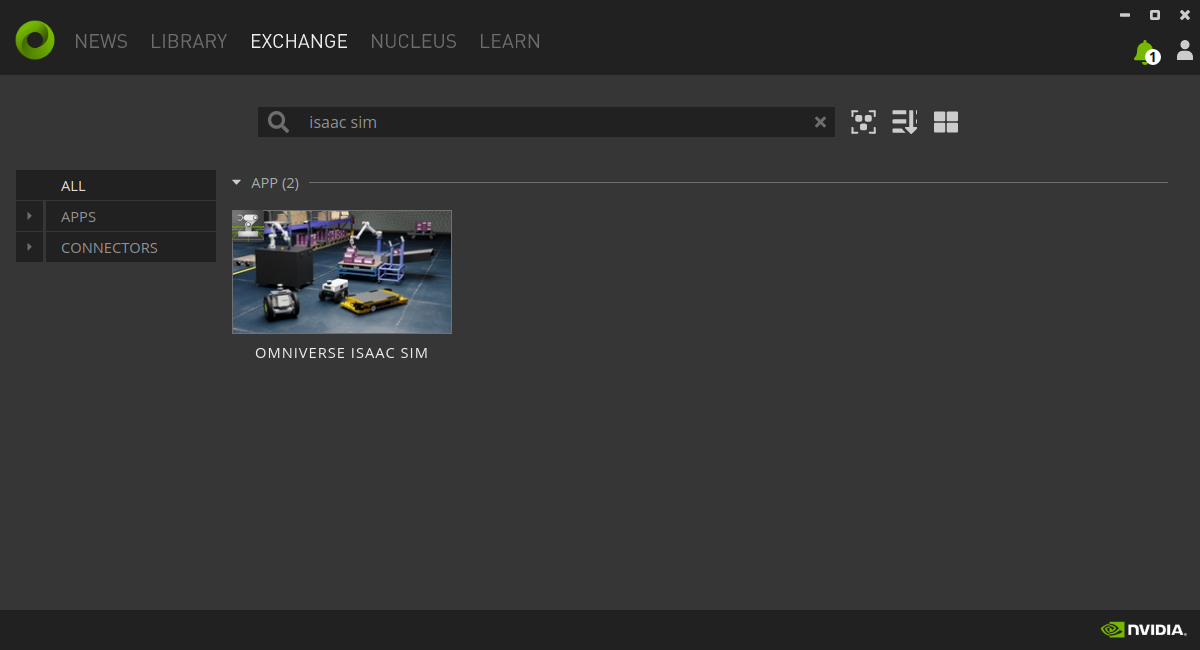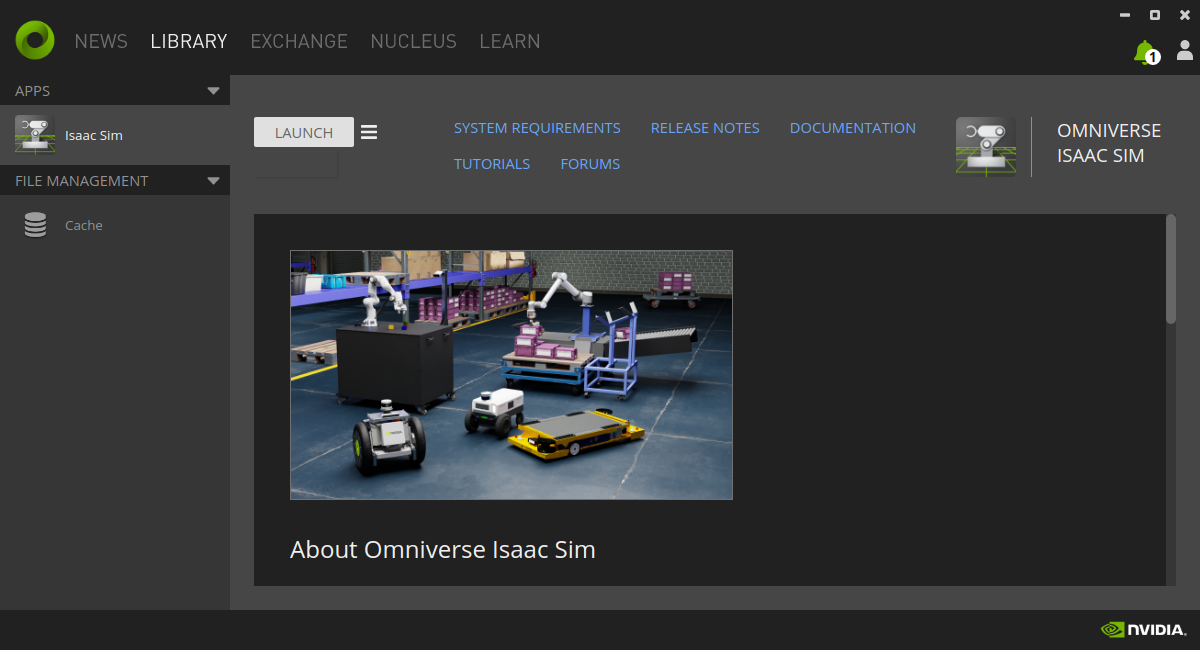https://github.com/nvidia-ai-iot/husky_demo
Husky Simulation and Hardware In the Loop simulation on Isaac SIM with Isaac ROS
https://github.com/nvidia-ai-iot/husky_demo
husky isaacros jetson-orin jetson-orin-nano
Last synced: 3 months ago
JSON representation
Husky Simulation and Hardware In the Loop simulation on Isaac SIM with Isaac ROS
- Host: GitHub
- URL: https://github.com/nvidia-ai-iot/husky_demo
- Owner: NVIDIA-AI-IOT
- License: mit
- Created: 2023-10-01T16:20:17.000Z (about 2 years ago)
- Default Branch: main
- Last Pushed: 2023-12-19T12:21:18.000Z (almost 2 years ago)
- Last Synced: 2024-05-14T00:14:41.864Z (over 1 year ago)
- Topics: husky, isaacros, jetson-orin, jetson-orin-nano
- Language: Python
- Homepage: https://developer.nvidia.com/blog/simulate-and-localize-a-husky-robot-with-nvidia-isaac/
- Size: 2.17 MB
- Stars: 9
- Watchers: 3
- Forks: 1
- Open Issues: 1
-
Metadata Files:
- Readme: README.md
- License: LICENSE
Awesome Lists containing this project
README
# Husky Demo

Tested on Isaac Sim 2023.1.0 and Isaac Sim 2023.1.1
## Hardware required
Workstation:
1. Internet connection
2. x86/64 machine
3. Install Ubuntu 22.04
4. [Install ROS2 Humble](#install-ros2-humble)
5. NVIDIA Graphic card with RTX
6. Display
7. Keyboard and Mouse
NVIDIA Jetson:
1. NVIDIA Jetson Orin Nano
2. Jetpack 5.1.2
Tools:
1. Router
2. eth cables
## Setup hardware and installation
Before to start check you have all requirements and connect the driver following this image

It is preferable to connect workstation and the NVIDIA Jetson Orin Nano with a lan cable and not use WiFi.
### Install ROS2 Humble on Desktop
Follow the Isaac Sim 2023 official documentation and check or install ROS2 Humble on your desktop [Running native ROS](https://docs.omniverse.nvidia.com/isaacsim/latest/installation/install_ros.html?highlight=native%20ros#running-native-ros).
In quick steps:
1. Download ROS 2 following the instructions on the official website: [ROS 2 Humble Ubuntu 22.04](https://docs.ros.org/en/humble/Installation/Ubuntu-Install-Debians.html)
2. Source the ROS environment in the terminal. You must perform this step each time before using any ROS commands.
```console
source /opt/ros/humble/setup.bash
Install vision_msgs_package
```
3. Install vision msgs package
```console
sudo apt install ros-humble-vision-msgs
```
### Install latest NVIDIA Isaac Sim
Follow the documentation on NVIDIA Isaac Sim [Workstation install](https://docs.omniverse.nvidia.com/isaacsim/latest/installation/index.html)
1. Download the [Omniverse Launcher](https://www.nvidia.com/en-us/omniverse/)
2. [Install Omniverse Launcher](https://docs.omniverse.nvidia.com/prod_launcher/prod_launcher/installing_launcher.html)
3. Install [Cache](https://docs.omniverse.nvidia.com/prod_nucleus/prod_utilities/cache/installation/workstation.html) from the Omniverse Launcher
4. Install [Nucleus](https://docs.omniverse.nvidia.com/prod_nucleus/prod_nucleus/workstation/installation.html) from the Omniverse Launcher
Open Omniverse Launcher

Move to Library and choice "Omniverse Isaac Sim" and download the latest 2023.1.1 version

### Install Husky Demo on your workstation
Clone this repository
```console
git clone https://github.com/NVIDIA-AI-IOT/husky_demo.git
cd husky_demo
```
Run this script that is also the installer for your workstation on all tools
```console
./husky_demo.sh
```
### Install Husky Demo on NVIDIA Jetson
In this section you connect to your NVIDIA Jetson with a ssh connection, open a terminal an write
```console
ssh
```
where **IP** is the of NVIDIA Jetson or **hostname** is the hostname of your board.
If you are connected the output from the terminal is:

Clone this repository
```console
git clone https://github.com/NVIDIA-AI-IOT/husky_demo.git
cd husky_demo
```
Add docker group to your user
```console
sudo usermod -aG docker $USER && newgrp docker
```
Set the default nvidia runtime
You're going to be building containers, you need to set Docker's `default-runtime` to `nvidia`, so that the NVCC compiler and GPU are available during `docker build` operations. Add `"default-runtime": "nvidia"` to your `/etc/docker/daemon.json` configuration file before attempting to build the containers:
``` json
{
"default-runtime": "nvidia",
"runtimes": {
"nvidia": {
"path": "nvidia-container-runtime",
"runtimeArgs": []
}
}
}
```
Then restart the Docker service, or reboot your system before proceeding:
```console
sudo systemctl restart docker
```
Run the installer and run script
```console
./husky_demo.sh
```
## Run demo
Now you can run your Husky demo, but you need to follow the steps below
### Run on your workstation
On the second terminal run, like the message appeared
```console
ros2 launch husky_isaac_sim robot_display.launch.py
```
This script will load husky on Isaac Sim and open rviz on your terminal

If you want, you can redock manually all viewports and obtain something like that

### Script to run on your Jetson Nano
If everthing went well from the [installation](#install-husky-demo-on-nvidia-jetson), you can run the command below
```console
bash src/husky_isaac_sim/scripts/run_in_docker.sh
```
now you will see husky mapping on your rviz

## Drive Husky
There are several options:
1. Drive by keyboard
2. Drive by joystick
3. Drive with Nav2
Follow below all options
### Drive by keyboard
Open a new terminal and run
```console
ros2 run teleop_twist_keyboard teleop_twist_keyboard
```
if this package is not available, install
```console
sudo apt install ros-humble-teleop-twist-keyboard
```
### Drive by joystick
Open a new terminal and run
```console
ros2 run teleop_twist_joy teleop_twist_joy
```
if this package is not available, install
```console
sudo apt install ros-humble-teleop-twist-joy
```
### Drive with Nav2
You can simply use rviz2 and press "Goal to pose" to select a new goal for Husky to achieve.
## Change Isaac Sim version
If you want to change Isaac Sim version on this demo you can simply do:
* Open `husky_demo.sh` file
* On line **33** change `ISAAC_SIM_VERSION` variable with your current version and write: `isaac_sim-`
If you don't know which version you have installed on your workstation open the library on the Isaac Sim page you will find below the button "launch" your current version installed
